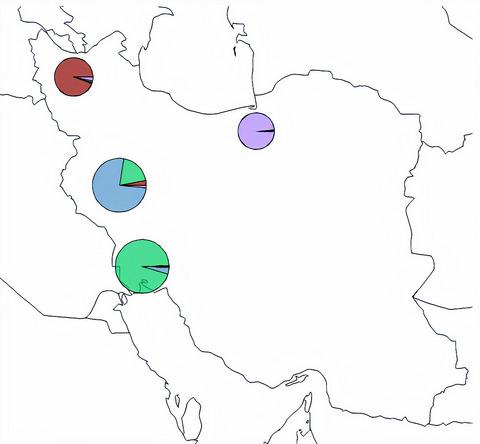当前位置:
X-MOL 学术
›
Plant Pathol.
›
论文详情
Our official English website, www.x-mol.net, welcomes your feedback! (Note: you will need to create a separate account there.)
Population genetic structure of four regional populations of the barley pathogen Pyrenophora teres f. maculata in Iran is characterized by high genetic diversity and sexual recombination
Plant Pathology ( IF 2.7 ) Pub Date : 2020-11-30 , DOI: 10.1111/ppa.13326 Asieh Vasighzadeh 1 , Bahram Sharifnabi 1 , Mohammad Javan‐Nikkhah 2 , Elaheh Seifollahi 1 , Doreen Landermann‐Habetha 3 , Alice Feurtey 3 , Eva Holtgrewe‐Stukenbrock 3, 4
Plant Pathology ( IF 2.7 ) Pub Date : 2020-11-30 , DOI: 10.1111/ppa.13326 Asieh Vasighzadeh 1 , Bahram Sharifnabi 1 , Mohammad Javan‐Nikkhah 2 , Elaheh Seifollahi 1 , Doreen Landermann‐Habetha 3 , Alice Feurtey 3 , Eva Holtgrewe‐Stukenbrock 3, 4
Affiliation

|
The leaf spot form of the barley disease net blotch, caused by the fungus Pyrenophora teres f. maculata (PTM), is an increasingly important foliar disease of barley. Studies of population genetic structure and reproductive mode are necessary to make predictions of the evolutionary potential of the pathogen. Sources of resistance to PTM have been found in Iranian landraces, which may have the potential to improve plant breeding efforts. However, little is known about the population genetic structure of this fungus in Iran. In this study, we analysed the frequency of the mating type genes to assess the potential for sexual mating of PTM collected from four provinces—Khuzestan, Hamadan, Golestan, and East Azerbaijan—and we investigated the population genetic structure using seven simple sequence repeat markers. High genotype diversity, linkage equilibrium, and equal ratios of mating types frequencies in the PTM populations at Khuzestan and Hamadan support the occurrence of sexual reproduction in these populations, while in Golestan and East Azerbaijan populations, significant gametic disequilibrium and relatively low genotype diversity suggest a higher incidence of clonality or different demographic histories. Unequal mating type frequencies in Golestan confirm a predominance of asexual reproduction. Finally, we found significant evidence for strong population structure with most of the genetic variation represented within regional populations (89%). Overall, our study provides evidence for high genetic variation in Iranian PTM populations, which may be the basis for rapid adaptive evolution in this pathosystem. This highlights the need for integrated efforts to control the disease.
中文翻译:

大麦病原体Pyrenophora teres f。的四个区域种群的种群遗传结构。伊朗的maculata具有高度的遗传多样性和有性重组的特征
大麦病网斑的叶斑形式,由真菌Pyrenophora teres f引起。斑ul(PTM),是一种日益重要的大麦叶病。为了预测病原体的进化潜力,必须研究种群的遗传结构和繁殖方式。在伊朗地方品种中发现了对PTM抗药性的来源,这可能具有改善植物育种工作的潜力。但是,对于这种真菌在伊朗的种群遗传结构知之甚少。在这项研究中,我们分析了交配型基因的频率,以评估从四个省(胡兹斯坦,哈马丹,哥尔斯坦和东阿塞拜疆)收集的PTM进行性交的潜力,并使用七个简单的序列重复标记物调查了种群的遗传结构。 。高基因型多样性,连锁平衡,在Khuzestan和Hamadan的PTM种群中,相等比例的交配类型频率支持了这些种群中的有性生殖,而在Golestan和东阿塞拜疆种群中,显着的配子不平衡和相对较低的基因型多样性表明克隆性发生率较高或不同人口历史。在Golestan中,不平等的交配类型频率证实了无性繁殖的优势。最后,我们发现了强有力的种群结构的重要证据,其中大多数遗传变异都体现在区域人群中(占89%)。总体而言,我们的研究提供了伊朗PTM种群中高遗传变异的证据,这可能是该病原系统快速适应性进化的基础。这突出表明需要综合努力来控制该疾病。
更新日期:2020-11-30
中文翻译:

大麦病原体Pyrenophora teres f。的四个区域种群的种群遗传结构。伊朗的maculata具有高度的遗传多样性和有性重组的特征
大麦病网斑的叶斑形式,由真菌Pyrenophora teres f引起。斑ul(PTM),是一种日益重要的大麦叶病。为了预测病原体的进化潜力,必须研究种群的遗传结构和繁殖方式。在伊朗地方品种中发现了对PTM抗药性的来源,这可能具有改善植物育种工作的潜力。但是,对于这种真菌在伊朗的种群遗传结构知之甚少。在这项研究中,我们分析了交配型基因的频率,以评估从四个省(胡兹斯坦,哈马丹,哥尔斯坦和东阿塞拜疆)收集的PTM进行性交的潜力,并使用七个简单的序列重复标记物调查了种群的遗传结构。 。高基因型多样性,连锁平衡,在Khuzestan和Hamadan的PTM种群中,相等比例的交配类型频率支持了这些种群中的有性生殖,而在Golestan和东阿塞拜疆种群中,显着的配子不平衡和相对较低的基因型多样性表明克隆性发生率较高或不同人口历史。在Golestan中,不平等的交配类型频率证实了无性繁殖的优势。最后,我们发现了强有力的种群结构的重要证据,其中大多数遗传变异都体现在区域人群中(占89%)。总体而言,我们的研究提供了伊朗PTM种群中高遗传变异的证据,这可能是该病原系统快速适应性进化的基础。这突出表明需要综合努力来控制该疾病。


























 京公网安备 11010802027423号
京公网安备 11010802027423号